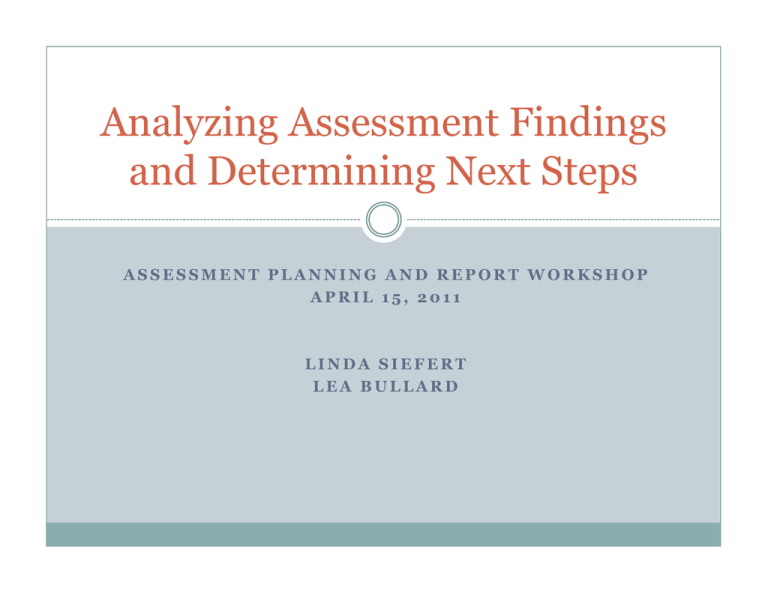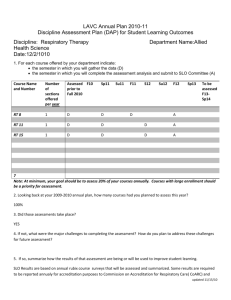Analyzing Assessment Findings and Determining Next Steps
advertisement

Analyzing Assessment Findings and Determining Next Steps ASSESSMENT PLANNING AND REPORT WORKSHOP APRIL 15, 2011 LINDA SIEFERT LEA BULLARD Two Audiences A theme that will be threaded throughout this workshop is that you have more than one audience for the information that comes from your assessments, including Your department faculty Those who will read your assessment report Objectives of the Workshop Ways to summarize the data that will be accurate, understandable and useful to each audience Approaches to engaging faculty in the analysis of the findings and find meaning in it Ways to take action to improve student learning Methods to clearly and concisely describe all these activities in the annual assessment report Summarizing Data Program assessment data does not require sophisticated statistical procedures. It does require presentation of findings that have meaning that can be interpreted in relationship to student understanding and to the curriculum. The presentation for within department decision making needs to be detailed. The presentation for those outside the department is best condensed with links to the details provided. Presenting Data from Rubrics SLO Average Below Expectations Met Expectations Exceeded Expectations SLO 1 2.0 0 (0%) 20 (100%) 0 (0%) SLO 2 2.0 5 (25%) 10 (50%) 5 (25%) SLO 3 2.0 10 (50%) 0 (0%) 10 (50%) Means hide important information about the distribution of scores. Providing std. devs. helps (0, .7, 1.0), but… What we really want to know is the percentage of students who meet the expected learning outcomes. More importantly, the mean is not statistically accurate for nominal or ordinal data. Ordinal Data Rubric data is ordinal. The values cannot be assumed to lie in equal intervals along a number line. 1 1 2 2 3 3 4 4 Other Issues with Summarizing Data Disaggregating the data is important when you have diverse populations that are of interest: Online, distance, or classroom-based programs BA degree vs. BS degree For student learning outcomes with multiple dimensions, provide data for each dimension. Reporting Assessment Findings Example Geology SLO 2 Example Anthropology SLOs 2 and 3 Example Creative Writing SLOs 3 and 4 Engaging Faculty It is vital to get faculty involved with analyzing the evidence. Find a block of time at least once a year to devote to a discussion of the evidence. Select only 1 – 3 outcomes for the discussion. Provide the meaningfully organized results. Have breakout discussions prior to full discussion. Pose specific questions: What do the findings say about students’ mastery of ____? What are the areas of strength? What are the areas for improvement? How do these findings relate to the components of the curriculum? Making the Data Real Data by itself can lack meaning, especially for the folks that do not have a direct hand in either creating the assignments and rubrics used for assessment or in scoring the products. Therefore it is also informative to include looking at student work as part of the analysis of assessment findings. Looking at Student Work Together Do you meet with other faculty members, on a regular basis, for discussion of specific pieces of student work? If so, how much? Once a year Once a semester Multiple times during a semester Looking at Student Work Together What it is: Collaborative and discipline-based Close look at students’ course work Holistic Structured conversation among colleagues What it is not: Top-down-driven Assigning judgments Removed from practice Another hoop Benefits Student work is discussed from a variety of diverse perspectives New faculty hear opinions of student work from experienced faculty Student work from a range of class levels is discussed Results can drive curriculum and pedagogy discussions Activity Using student work samples from General Education Assessment, let’s do a short collaborative investigation session Session structure: Introduce assignment and scoring rubric Assemble small groups Read and preliminarily score student work Discuss scores and issues within small groups Reconvene and discuss with whole group Activity Discussion Scores assigned by General Education Assessment faculty scorers Example 1: level 2 Example 2: level 0 Example 3: level 1 Example 4: level 3 Example 5: level 4 What issues or interesting points arose during your discussion? What possible directions might this activity suggest? Making Looking at Student Work a Practice Develop a session structure Schedule a session when most faculty will be there Allow time to read 2-3 pieces that faculty volunteer to share Take good notes from the session Determine how to use the information gleaned from the meetings Next Steps By looking at the data and student work, areas for improvement will be evident. Examples: Many students struggled with statistical analysis. A third of the students did not synthesize theory with research. Half of the students’ reflections were superficial. Why? How does this relate to the curriculum? The expected SLO is not taught in the curriculum. The SLO is addressed but not often enough, or not at the right time, or the requirement is not made clear enough. There is faculty disagreement about the specifics. The assignment does not elicit the necessary performance. Next Steps - Recommendations For simple items, recommendations for improvement may come from the initial meeting. For more complicated issues, a sub-committee may need to be tasked with making recommendations. Set a timeline for bringing the recommendations back to the faculty and for faculty discussion and approval. If the approval and action occur after the annual report: In the current year report, note that recommendations are in the works, along with the timeline In the next reports over the next year(s), document the changes made, noting they are from the previous year’s findings, and then changes to assessment results based on those changes. Reporting Changes and their Results Year 1 Report Year 2 Report The Undergraduate Curriculum committee is charged with studying the possibility of requiring majors to take STT 215 to improve statistics skills or alter our research course to enhance the statistics covered. Based on previous assessment results and the recommendations of the Undergraduate Curriculum committee, the department as added STT 215 as a requirement of the major starting in the Fall 2011 catalog. Based on the assessment findings, the portfolio reflection prompt will be enhanced starting this year. In addition, reflection will be added to the curriculum starting in the 210 course. All but one portfolio evidenced at least satisfactory achievement of this learning outcome. Our recently-altered assignment prompt for the portfolio, along with the emphasis given to every instructor regarding the importance of reflection in the learning process, seem to be starting to make an impact. Reflective assignments now being used in the gateway course should bring further improvements in coming years, as those students progress through the program. Conclusions Ask faculty opinion on useful ways to present data Make time for at least annually for discussion of results at a faculty meeting or retreat Document the discussion and any recommendations from it Act on the recommendations On the Assessment Report Under Summary of Findings present the discussion of meaning, with a brief summary of data and/or link to full results Under Actions Taken present actions taken and to be taken; follow up the next year of actions to be taken.





